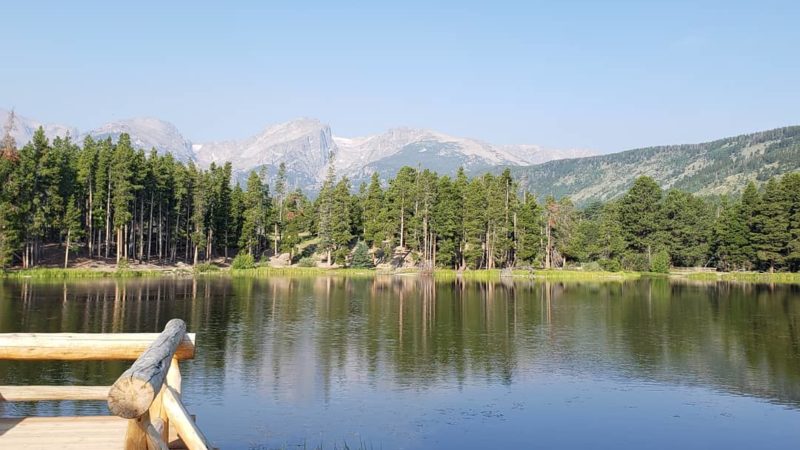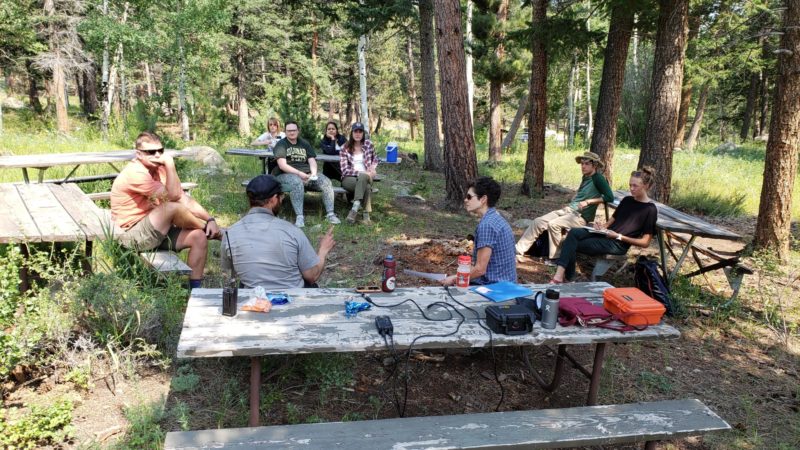
By Michael Childers and Ariel Schnee
This summer, eight CSU history graduate students returned to Rocky Mountain National Park to participate in the ninth session of the Public Lands History Center’s Parks as Portals to Learning (PPL) field workshop.
Led by the center’s Program of Research and Scholarly Excellence (PRSE) fellow and second-year graduate student Amber Scott, the group built upon previous participants’ research on wilderness management. Together, Jacie Rex, Shaun Rose, Paige Rooney, Taylor LaPointe, and Kristy Ornelas examined the park’s management of wilderness campsites.
The team spent time discussing present-day wilderness management with Wilderness Office Manager Barry Sweet, Trails Program Supervisor Doug Park, and Facilities Manager Daniel Lawson. Finally, they observed History Professor Emerita Ruth Alexander conduct an oral history with Wilderness Ranger Jacob Seidel on the park’s work to reclaim wilderness campsites following last summer’s Cameron Peak and East Troublesome fires. The group also delved into archival records that chronicled the history of the park’s Wilderness Office (formerly the Backcountry Office), looking for ways that the park had changed its campsites as visitor demand for backcountry camping mounted over time.
For the National Park Service, keeping things the same is one of the agency’s most treasured goals. Sweet likes to remind park visitors: “We think this place will be here 4,000 years from now… We want it to look just like this in 6021.”

History of RMNP wilderness preservation
As the participants in Parks as Portals to Learning 2021 found out, keeping things the same at national parks usually means making big changes. Nationally, one of the largest changes to encourage preservation was the Wilderness Act of 1964. The Wilderness Act mandated that public land managers take steps to identify and preserve spaces on public lands that would be kept free from machinery, roads, buildings, and other human intrusions on the landscape. While Congress did not legally designate acreage at Rocky Mountain National Park as “wilderness” until 2009, a boom in backpacking at the park in the 1960s and 1970s sparked an early re-evaluation of the park’s backcountry management practices.
Adapting to new demands on the park’s backcountry resources started with a trial backcountry permitting program in the mid-1960s. In order to save heavily-used places in the park, such as Fern Lake, park managers ended the practice of allowing visitors to select their own campsites, intentionally spreading visitors out over larger areas of the park’s backcountry.
Over the years, the park developed new systems and ways of being in wilderness, designating over 260 campsites, adopting a permanent permitting system for site reservations, and constructing infrastructure such as fire rings, site markers, signage, tent pads, and privies in an attempt to balance resource protection with visitor access to the spirit and aesthetic of wilderness.
Using history to plan the future
The result of the students’ work is a database that will help land managers access and apply historic information to guide decision-making about wilderness campsites in the present. The team wrapped up the week by presenting their research to National Park Service personnel. Following the team’s presentation of their findings, park staff asked questions on a wide range of topics, including equality and diversity within the park and the impacts of the park’s decision to implement a timed reservation system for all visitors last year.
View the full presentation below to learn more about the project, gain insight into the team’s experience at the park, and hear the pressing questions the park’s top staff are wrestling with as they plan to protect the national park’s lands and resources for 6021 and beyond.